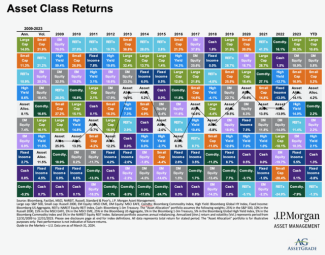
Understanding the Asset Class Periodic Table
The asset class periodic table is a useful tool to help investors understand the characteristics of different types of investments and how they may fit into a diversified portfolio. Let’s begin with the end in mind.
The asset allocation portfolio (white box in every column) illustrates how spreading investments across a variety of asset classes can reduce overall risk with more consistent relative returns: never at the top, never at the bottom.
The table visually categorizes nine different types of investments based on relative annual returns over 15 years providing investors with information to assist them with making informed decisions about where to allocate their money.
Understanding the periodic table
- The columns - each of the past 15 years (20XX to 2023).
- The rows - each of the nine asset classes and the one asset allocation portfolio sorted by top returns to lowest returns for that column’s year.
- Each color-coded box represents one of the nine asset classes with white representing the asset allocation portfolio. The colors do not change year to year, only their sorting based on rate of return.
- Each asset class is defined by a market index. Large cap stock is represented by the S&P 500 Index, for example. The asset allocation portfolio is a combination of all the indices. DEFINITION PAGE
- Seeing how asset class returns move from year to year in the columns helps illustrate how volatile those returns can be. This is important as the asset class outperforming most recently gets the most press. Often investors don’t appreciate how risky those investments can be.
For example, EM equity or Emerging markets, often follows a year of outperformance with a year of dramatic underperformance. It had negative returns in 7 of the 15 years.
Looking at large cap stocks, you see that over the last 15 years, this asset class has stayed in the top 2/3 of table and had a negative return in only 3 of the 15 years.
Periodically reviewing the performance of various asset classes can help alert you to the need to rebalance your portfolio. While it is great when an asset class outperforms, you don’t want it to become so large a portion of your portfolio that a decline in performance introduces too much risk.
Do you need a better understanding of how much risk you have in your portfolio? Call us to discuss how we can help you evaluate your planning and investment need

